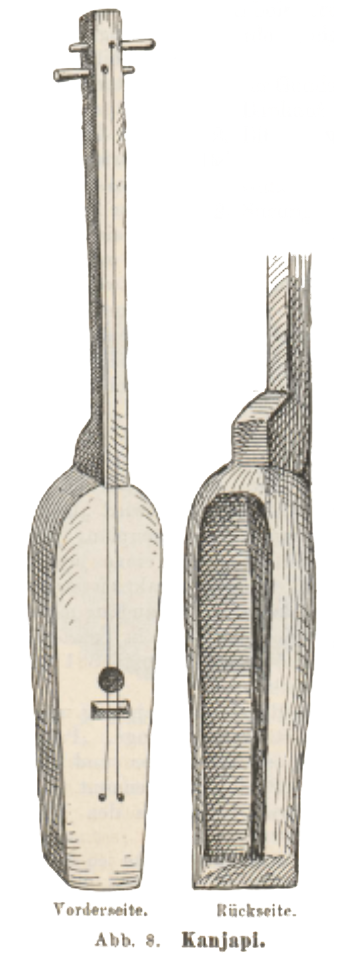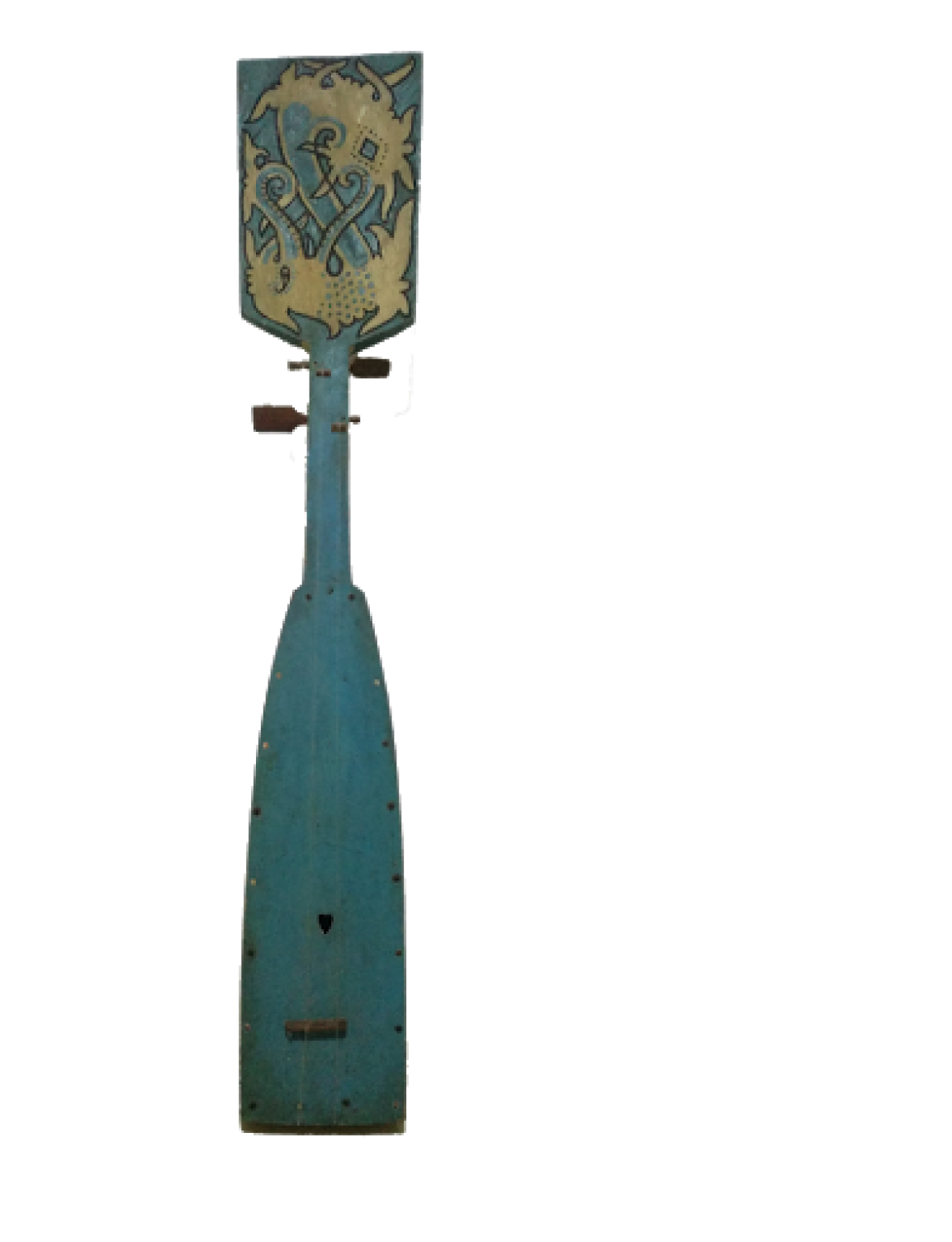
History of Boat Lutes
Boat lutes; plucked string instruments carved from one piece of wood, are members of the chordophone family. Their hollowed bodies look a bit like a boat hence their name!
Found throughout Borneo Island, boat lutes come in a variety of shapes and sizes- some have small bodies and long necks, others have stout bodies with short necks and moveable frets. At the end of the neck sit tuning pegs and a carved headstock, often in the shape of a hornbill head, an Aso– dog/dragon creature, or an ox, horse or crocodile- animals that traditionally played a significant role in agricultural, cultural and spiritual lives.
The instrument’s stomach can be hollowed from the front or back, and is sometimes covered with a sound plate for acoustic reverberation. Traditionally with two or three strings made of rattan or root fibres, nowadays nylon string, fishing wire or metal guitar strings are more commonly used.
Held like a guitar, the fretted bottom string is plucked with the index finger as the rhythmic melody/ostinato, while the second or third strings are plucked occasionally as an accompanying drone. Only in recent years have boat lutes been adapted to standardised tuning to allow them to play modern music and scales.
Found throughout Borneo Island, boat lutes come in a variety of shapes and sizes- some have small bodies and long necks, others have stout bodies with short necks and moveable frets. At the end of the neck sit tuning pegs and a carved headstock, often in the shape of a hornbill head, an Aso– dog/dragon creature, or an ox, horse or crocodile- animals that traditionally played a significant role in agricultural, cultural and spiritual lives.
The instrument’s stomach can be hollowed from the front or back, and is sometimes covered with a sound plate for acoustic reverberation. Traditionally with two or three strings made of rattan or root fibres, nowadays nylon string, fishing wire or metal guitar strings are more commonly used.
Held like a guitar, the fretted bottom string is plucked with the index finger as the rhythmic melody/ostinato, while the second or third strings are plucked occasionally as an accompanying drone. Only in recent years have boat lutes been adapted to standardised tuning to allow them to play modern music and scales.
Found throughout Borneo, they are cousins to the more well-known and documented boat lutes of the Philippines, including the Kusyapi, Kudyaipi and Kesapi. They are distantly related to the Chapey from Cambodia, and the Kacapi or Kucapi of Sulawesi and Sumatra. The Sanskrit root of many of these instruments’ names suggest they may be related to the ancient Indian Kacchapi Vina, indicating a history that is closely tied to thousands of years of trade and travel (Brandeis, Maceda, Yampolsky).
As an island made up of three nations, and hundreds of different indigenous groups, many communities in Borneo have their own unique version of the boat lute. The family members include the broad long-bodied Orang Ulu Sapé, the long necked Sundatang of Sabah played by the Rungus, Dusu and Kadazan communities, the thin bodied Tapi of the Lun Bawang and Lun Dayeh, the fretless Belikan of the Iban, the small Brunein Kasapi, and in Kalimantan the Ngaju Kacapi, the Ot Danum Konyahpi, and the rare “short-necked shovel” Sape Kaayan, also known as the sape ting dua.
Different indigenous communities call these instruments by many different names, and while some are experiencing a vibrant contemporary revival some of these instruments are highly endangered and almost impossible to be found practiced or even remembered by the communities who once played them.
As an island made up of three nations, and hundreds of different indigenous groups, many communities in Borneo have their own unique version of the boat lute. The family members include the broad long-bodied Orang Ulu Sapé, the long necked Sundatang of Sabah played by the Rungus, Dusu and Kadazan communities, the thin bodied Tapi of the Lun Bawang and Lun Dayeh, the fretless Belikan of the Iban, the small Brunein Kasapi, and in Kalimantan the Ngaju Kacapi, the Ot Danum Konyahpi, and the rare “short-necked shovel” Sape Kaayan, also known as the sape ting dua.
Different indigenous communities call these instruments by many different names, and while some are experiencing a vibrant contemporary revival some of these instruments are highly endangered and almost impossible to be found practiced or even remembered by the communities who once played them.


Traditionally used for celebration, spiritual practice and shamanic healing rituals, boat lutes played a significant role in many facets of life. Most often played by men, in some communities it was taboo for women to play the boat lute, however in Sabah the sundatang was played by the highly revered high priestess Bobolians during healing rituals.
In modern times some of these instruments are having a revival on the contemporary music scene- for example the Sape’ which has become a symbol of Sarawak’s blossoming creativity, or the Kecapi of Kalimantan, played in accompaniment with other instruments in lively Kalteng bands.
We hope our Borneo Boat Lute Revival initiative will pay a small role in highlighting these unique instruments and encouraging people to find out more about them.
In modern times some of these instruments are having a revival on the contemporary music scene- for example the Sape’ which has become a symbol of Sarawak’s blossoming creativity, or the Kecapi of Kalimantan, played in accompaniment with other instruments in lively Kalteng bands.
We hope our Borneo Boat Lute Revival initiative will pay a small role in highlighting these unique instruments and encouraging people to find out more about them.
Disclaimer
All information on the Borneo Boat Lute Revival website is based on research findings conducted by the team and/or sharings of knowledge by its community contributors. It is subject to changes and updates at any time. To discuss any information or use of material from this site, please reach us at hello@borneoboatlutes.com.
Get In Touch
A great deal of thought and deliberation went into every piece of information in the archive before it was finally accepted for inclusion. We’d love to hear from you if you’d want to keep the conversation going! Inquiries, comments and recommendations are always welcome.
catriona.catama@gmail.com
Sign Up For Our Newsletter
Subscribe to our mailing list to stay up-to-date on our revivalist movement, artists, and other upcoming activities!

